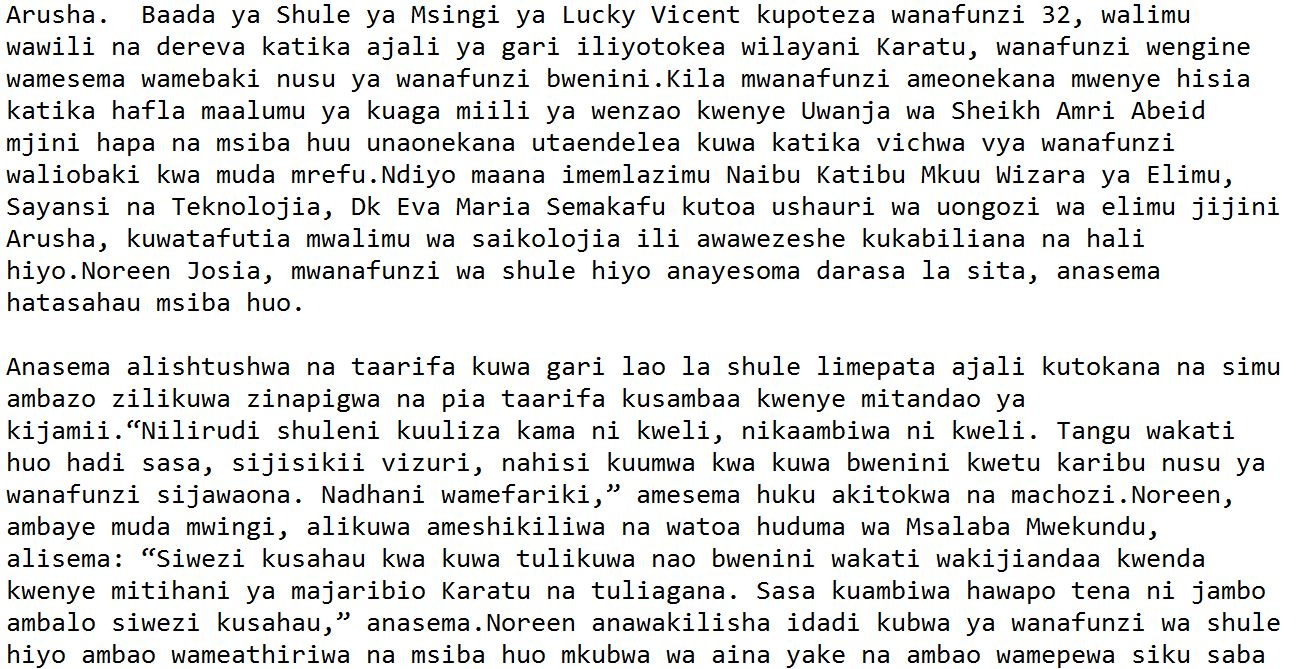Loading...
Home
» BREAKING NEWS
» KITAIFA
» Arusha. After Primary School Lucky Vicent lose 32 students, two teachers and a driver in a car accident that occurred in Karatu district, other students
Arusha. After Primary School Lucky Vicent lose 32 students, two teachers and a driver in a car accident that occurred in Karatu district, other students
MAAJABU YA MTANDAONI,BOFYA HAPO CHINI HUTAAMINI MACHO YAKO
Farmers work, middlemen profit OPINIONS
Small-scale farmers do a lot of work,
but when they sell their products,
prices are less than what
they were 15 years ago.
Peter Kamau and Philomena Nyagilo
John Mbugua is a farmer in the Kinale
area in Kiambu district. It is Thursday
morning and he has delivered
300 cabbages from his ½ -acre plot to
soko mjinga market along the NairobiNaivasha
highway. The scenario
looks promising in terms of business.
The market is full of activities,
with farmers, traders and middlemen
bargaining for better prices. Mbugua
sells the cabbages at Ksh 3 apiece. He
pays Ksh 1 apiece for transport to the
market and Ksh 20 cess to the local
county council for the consignment.
Mbugua is well known in soko mjinga.
“I have been here for a long time”, he
says, “but the situation is not getting
any better.”
David Thugu transports four big
bags of sukumawiki to soko mjinga.
On his 1-hectare piece of land he plants
cabbages, sukumawiki and carrots.
Thugu pays his casual workers Ksh
150 a day. Going to the market, he has
to pay Ksh 50 for the five sacks on the
donkey cart, not to forget the contr bution to the local council: Ksh 40 for
parking the donkey and Ksh 20 for
the trading space. This morning, he is
offered Ksh 200 for 1 full bag of sukumawiki.
“This is the same amount as
15 years ago”, says Thugu, “but now
we have higher production costs. The
price of all commodities has gone up.
For instance, the price for a bag of
fertilizer has gone up to Ksh 2,000.
This means that I am getting less than
what I got 15 years ago”, he says.
Smiling faces
On this chilly and foggy day only the
faces of the middlemen and traders
are smiling. They have parked their
hired trucks and pick-ups beside the
market and wait for the middlemen
to haggle for prices with the farmers.
The middlemen buy directly from
the farmers. They decide and mark
up the prices for cabbages, sukumawiki,
carrots, spinach and potatoes
for that particular day, depending
on the demand from the traders and
the amount being supplied. Although
most of the farmers here in soko mjinga
do have a mobile phone, they do not
make any effort to find the market
price for the day, as David Thugu
confirms.
TAFADHALI SHARE HABARI HII KWA RAFIKI ZAKO HAPO CHINI ILI IWAFIKIE NA WENGINE PIA
Pig industry sustains livelihoods of many families in Kenya. Pig rearing has been one of wellestablishedindustry
in Kenya following growing export markets and increasing number of health
conscious consumers. Pig production if efficiently managed has great potentials for increasing
protein supply in Kenya. Smallholder pig farms in Tharaka-Nithi County have been facing
varying and dismal profits. The main objective of this study will be to establish which
institutional arrangements and management factors affect the profit efficiency of small-holder
pig farmers in Tharaka-Nithi County. A multi-stage purposive sampling technique will be
adopted to collect cross sectional data of eighty (80) smallholder pig farmers in Maara
Constituency by the use of semi-structured interview schedules. The work will employ Data
Envelopment Analysis to come up with profit efficiency rankings among the farmers and
stochastic frontier profit function will be used to analyze the factors that affect profit efficiency.
The data will be processed using STATA and DEA Frontier packages. The findings could be
useful to the stakeholders of the pig industry sub sector to formulate policies pertaining to pig
enterprise inputs, marketing issues and financial products and also can establish benchmarks
which can be used as a package for enhancing and stabilizing profit efficiencies of smallholder
pig farmers which in turn could help improve the Kenya economy.
An Overview of Livestock Sub-sector in Kenya Perspectives, Opportunities and Innovations for Market Access for Market Access for Pastoral Producers Recent statistics point that the livestock sub-sector in Kenya accounts for approximately 10% of the National Gross Domestic Product (GDP). This is 30% of the agricultural GDP. It employs about 50% of the national agricultural workforce and about 90% of the ASAL workforce. 95% of ASAL household income comes from this sub-sector. This is despite the fact that the sector receives only 1 % of the total annual budget allocation. The livestock resource base is estimated at 60 million units comprising of 29 million indigenous and exotic chicken, 10 million beef cattle, 3 million dairy and dairy crosses, 9 million goats, 7 million sheep, 0.8 mi camels, 0.52 mi donkeys and 0.3 million pigs. (Strategy for Revitalizing Agriculture (SRA) 2003) Kenya is broadly self-sufficient in most livestock products but is a net importer of red meat mostly inform of on-the-hoof animals trekked across the porous boundaries of neighbouring countries- Somalia, Ethiopia, Sudan, Uganda and Tanzania. Livestock supply in Kenya results from a complex set of interactions between Kenya and its neighbours and the traditional Middle East market and their respective livestock populations, demand and market prices. Kenya is part of a regional market where livestock flow according to markets and price differentials in a liberalized system throughout the region as a whole and where Nairobi represents a focus of demand for the region Supply of red-meat from domestic cattle, shoats and camels falls short of demand, and is almost permanently augmented by a traditional livestock trade drawn in from neighbouring countries, especially Somalia, Tanzania, Sudan and Ethiopia in varying quantities according to demand, which maintains a supply/demand
[1.6MB]SIJAAMINI WEMA SEPETU ANACHOKIFAYA HAPO KWENYE HII VIDEO BOFYA UONE
CodeNirvana










